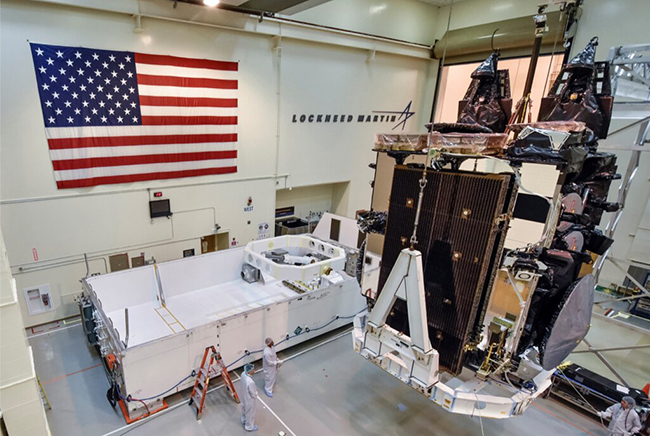
The Air Force’s Advanced Extremely High Frequency satellite, built by Lockheed Martin, is set to launch from Cape Canaveral AFS, Fla. on Aug. 8, 2019. Lockheed Martin photo.
The Air Force’s fifth Advanced Extremely High Frequency satellite is set to launch Aug. 8, marking the first launch under the recently reorganized Space and Missile Systems Center.
AEHF-5 is part of an effort to replace the older Milstar military communications constellation with electronic jamming-resistant technology that can transfer larger batches of information. One AEHF satellite provides more capacity than all five Milstar satellites combined, according to Lockheed Martin. The satellite, which is built by Lockheed and costs $1.1 billion, will launch from Cape Canaveral AFS, Fla. The program is comprised of six satellites.
AEHF-5 was originally slated to head to space June 27, but was delayed when testers discovered problems with a supplier-built component of United Launch Alliance’s Atlas V rocket, as well as a rocket battery failure. Gary Wentz, ULA’s vice president of government and commercial programs, said during an Aug. 5 call with reporters he doesn’t anticipate any further delays.
“The teams removed the suspect hardware from all our launch vehicles, and we’re in the process of incorporating some changes to that hardware,” Wentz said. “They were relatively minor, but we’ve made those updates and we’ve gone through the appropriate retesting and reinstalled that hardware on the vehicle.”
For the first time, the Atlas V will also drop off an experimental Air Force cubesat to test orbital debris tracking before the rocket delivers AEHF-5.
The most recent AEHF launch took place in October, and the sixth satellite is scheduled to enter orbit next year. In the meantime, SMC could further tweak how it approaches launches as a result of its “SMC 2.0” revamp.
SMC 2.0 pushed responsibilities down from the center’s commander to individual programs and looks to leverage resources across initiatives rather than keep each program in its own silo. New portfolio architects are tasked with thinking about similar pieces of the space mission, and employees are grouped to handle development, engineering, logistics, and other issues faster and more cost-effectively.
After declaring initial operational capability last fall, SMC on July 31 officially closed parts of its old structure and declared its recently created organizations ready to stand on their own.
“We’re not just looking at individual capabilities, but we’re also looking across the whole mission area at how we can leverage international partners, and rideshare opportunities, and commercial as well as our military purpose-built systems to be able to tie everything together and deliver more enterprise solutions,” Col. Ryan Gulden, SMC’s satellite communications capability integrator, told reporters.
The second GPS III satellite, another Lockheed product, is set to enter space Aug. 22. The first was launched in December 2018.
